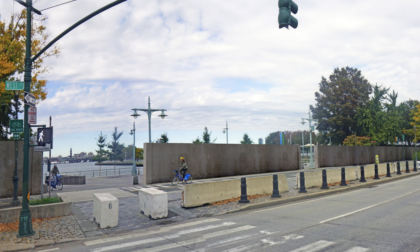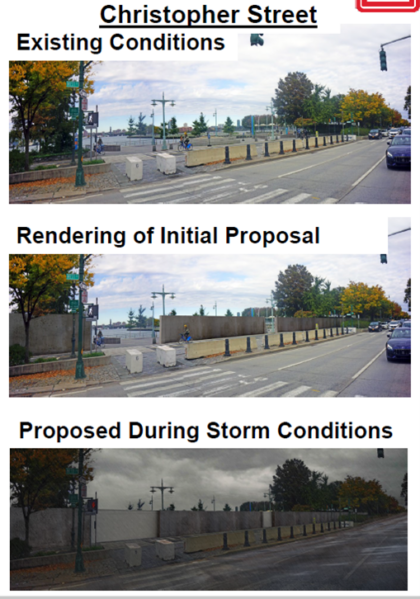In the News: The Oped we’ve been waiting for

The Times has an oped — thank goodness — that takes on the Army Corps’ plan for the west side that would most definitely ruin everything we value about living next to the river — and undo all the work that has been done over the past three decades to make the waterfront accessible. They call it destructive and inadequate and recommend that the Corps “should set aside their flawed proposal and turn to something better…for the sake of our waterfront and the communities excluded by the current plan.”
I was just hoping the wall proposal was one of those things that never gets built (the Army Corps has been working on the plans since 2016) since it is outrageous and not all that inventive. The 50 miles of 12-to-20-foot walls would snake along waterfront neighborhoods across the city and New Jersey, a permanent barrier not just for floods but for views. The Times has great illustrations to give a better sense of the impact than the Army Corps presentation did.
NB: Battery Park City Authority is moving right along with a similar plan for 200 feet of the bikeway/walkway between Chambers and Harrison. They are presenting 30% progress drawings for this plan on Monday, and I suggest getting to the meeting if this sounds like a bad idea to you. See info on that here.
But back to the oped, written by Robert Yaro, the former president of the Regional Plan Association a board member of Metro Flood Defense, a non-profit with a mission to increase public understanding of the flooding challenges in the NY-NJ Metropolitan Region (to do that they translate complicated scientific and technical reports into digestible material); and Daniel Gutman an environmental planning consultant and a member of the New York-New Jersey Storm Surge Working Group.
They are not burying their heads in the sand, rather they note that “New York City is the most vulnerable city in the country [for coastal storm flooding], according to Climate Central, a nonprofit research organization. As global warming raises sea levels, more of the region will be at risk, and the likelihood of Sandy-scale flooding will increase.” But they argue that this plan won’t save us.
They note that:
- the plan is estimated now at $52.6 billion — the most expensive project ever proposed by the Army Corps of Engineers.
- the floodwalls will require expensive modifications to New York City’s drainage system and costly pump stations to prevent neighborhoods behind the walls from being flooded by rainwater
- the plan would leave about 40 percent of vulnerable and low-income areas at risk of coastal flooding, in what they are calling “climate redlining”
- the city and state are going along with the plan, most likely, to ensure funding from the federal government
They also outline and explain the prospects of some alternatives, already studied by the Corps, the most promising, they say, is an offshore barrier system — a six-mile storm surge barrier between Breezy Point and Sandy Hook that would be deployed every couple of years. That in tandem with nature-based solutions, such as coastal wetlands and dunes, as well as some rebuilt shoreline features would be effective in protecting 90 percent of the city’s shoreline.
“Despite its great ambitions,” they write, “the Corps’s plan demonstrates the shortcomings of relying on massive shoreline structures for flood protection. If built, this plan could reverse the region’s decades-long effort to open up its waterfront for recreation while, at best, protecting only a small fraction of the region’s most vulnerable areas from devastating storm surge flooding.”















Amen.
The original Army Corps plan brings to mind the expression “cutting off one’s nose to spite one’s face.”
For those interested in a fantastic exploration of the effect rising seas will have on our coastal communities, highly recommend the Pulitzer finalist “Rising”, by Elizabeth Rush. Humans will need to engage in a variety of mitigation plans—including the restoration of coastal marshes, swamps, oyster beds, etc. and perhaps a few strategically placed sea (not land) walls to buy some time—but in the long run there will be little choice but retreat from the most flood prone developed areas of our coastline.
Worth noting that much of “prime TriBeCa” is built on top of former swampland (that the canal below “Canal Street” was meant to help drain), and is already within federal flood zones (and this is without meaningful sea level rise).
“the plan would leave about 40 percent of vulnerable and low-income areas at risk of coastal flooding”
Odd. You think those areas would get 100 percent coverage, since high-income NYers will be fine, or do what they eventually do: move.
So what’s the plan to keep this already monstrously ugly wall from becoming even uglier, via the inevitable total vandalism by graffiti, posters, advertising, etc.?
Not to build it. Just an inexcusably awful plan.
There needs to be a better plan from the Army Corp and from the Battery Park City Authority. Thanks to the NYT authors and this publication for publishing the voice of reason.
I had written the army corps when you first posted about this awful plan and heard nothing back from them.
There is a much better alternative to protect these areas at the narrowest points of waterway like they do in London with the Thames.
The flood gates can be opened and deployed when necessary and much less intrusive when not needed
There is a much better, modern and clever way to do this than this very army like fortifications approach!
The $1 billion (and counting) plan to remake northern Battery Park City a mere 43 years after it was designed with resiliency in mind is based on a “possible” rise in water level of the Hudson River of two-and-a-half feet by 2050.
Currently the water level in the Hudson is rising at a rate .125 inches per year.
It would have to rise eight times as fast as it is now to reach the fantastical projection of the BPCA. Unfortunately, community meetings that allow us to mingle with contractors do not allow discussion of rationale for these fabulously expensive (and possibly unnecessary) plans.